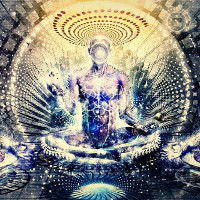Brain wave frequencies are temporal frequencies, and when you drop down into the theta band, you sync up with the geomagnetic field around us. This opens a portal, and your consciousness shifts into an atemporal space which is where most of the deceased linger for a time, the Buddhist bardo. They are more deeply embedded in that state than a dreamer is though, so a dreaming mind is just sort of ghostly for them. It might trigger recognition and memory, sometimes allowing coherent communication with the sleeper. This whole process is the basis of all shamanic practice. The state the “ancestors” inhabit just being one of many possible, as far as spacial portals go, visionary experiences, points of radically altered consciousness, hyper accelerated creativity.
One source calls precognition, post-cognition and creative genius all hyper-cognition. The seemingly linear and isolating confines of normal causality are suspended, and more possible states of brain function occur in the same place at the same time.
I like that word, hyper-cognition. Arguably, it’s also the basis of another theory of consciousness. Quantum theories involve a collection of super-positions all occurring and resolving themselves in the brain, a constant quantum soup of multiplexed possible signals.
Is remote viewing opening a portal? It is, yes. Consciousness itself, specifically attention, is portal based, but any localization of consciousness, information, energy is a portal behaving like a strange attractor in chaos theory.
Magic mirror. Yes. The only so called real space is just the degrees of freedom or phase difference between any two observers. So you incorporate traits, information, mass and energy sort of like the hypothetical black hole does, but you don’t draw exclusively from so called real space. You draw up from a well of – I guess you could call it – subspace, or hyperspace, and emit outward, combining and recombining information and energy in ways that have a very real impact on your environment.
Madness is a big phase difference? Madness is a big phase difference. It’s a really bad temporal/contextual smear. Most commonly a temporal disconnect as most forms of madness involve the person being cut adrift in one key point of trauma, very often something that took place in the developmental stages.
I suppose you could even address Alzheimers as a non-localization. Indeed. You can even track the temporal stress in their brain. Alzheimers hits primarily the hypocampus before it affects much else, but contextual or spacial distortion is a sensory issue. For one reason or another, they have exerted great effort to dislocate fragments of their perceptual consciousness so they wind up forming perceptions that have very poor ability to inform them about their localized space and condition.
Interesting what a wide array of approaches there are to things if you stop getting hung up on the material view of everything. Yes.
A little gravitic shifting would help Alzheimer patients a great deal. This is why they can become so animate under special stimuli like a favourite song. The incoming well recognized pattern of information energy temporarily attenuates their consciousness or attention. For a short while they are lucid before they slide back into the temporal sludge. They are looking for answers in the organic brain, and its bio-mechanics, that will never emerge. Consciousness is primary, not tertiary.
A lot of illness are stress fractures in our consciousness. We hold it so rigid with no exercise. Yes, or as shamans call it, soul loss.
Your thoughts are welcome. Be well friends.
Travis Saunders
Dragon Intuitive
~science,mysticism,spirituality~


